#Tudor Jewellery
Explore tagged Tumblr posts
Text
Necklaces of triangles-Part 2: Woman with cross
On left is portrait which Trinity College, Oxford(UK) has for over 400 years labelled Elizabeth Pope, neé Blount. (They have 3 copies of it and they are really hard to tell apart).They truly believe it is wife of one of their founders. There is just one problem with it. On left is portrait which Indiana University Art Museum(USA), has labelled as Mary I. Clearly this is a same woman!
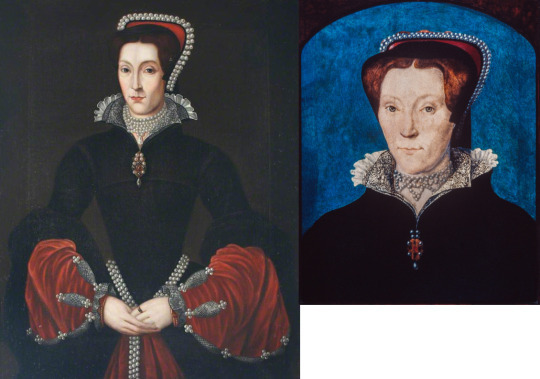
Either one is wrong or both are! So who is right? British university or American?(the sentence to start a fight.) Let’s find out.
Imo both might wrong at least partially. Both universities think their painting is based upon 1550s fashion. But I’ve done some digging and it can be as early as c. 1547-1548(which tbh was bit of surprise to me. But ok, chronology is once again shifted a couple of years.) So both are wrong in assuming it must be later. Then being wrong by only couple of years happens a lot in portraits. Let’s cut them so slack, they were not 20+ years away.
Indiana University Art Museum has it theirs labelled as Mary I, c.1550-1560 by Hans Eworth:
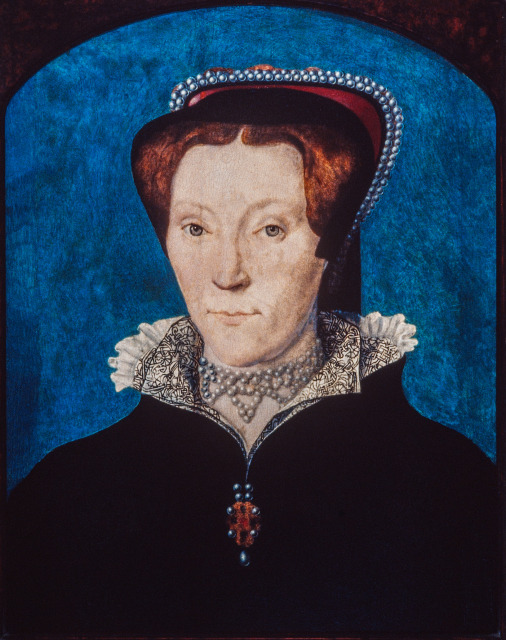
Link:https://artmuseum.indiana.edu/collections-online/browse/object.php?number=2001.39
Given that slight yellowish hue, this looks more like hazel eyes to me than grey.
Which is important because all 3 royal ladies in question had grey or hazel eyes. Not brown, not blue, hazel or grey. (I say three because obviously, this is not Anne of Cleves. It’s not her features.)
I am unsure if this smaller painting is original painting or not. And reason for it is you cannot see where dress and parlet end-which is wrong, not historically accurate.
However there is painting of Mary, where seemingly there is no difference too, untill you brighten it(as i did on left):
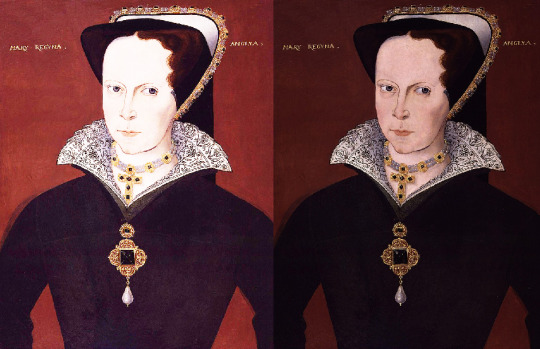
I tried it on Indiana version of our unknown lady. No partlet was revealed. But it is possible it was overpainted. Thus potentially a later alteration made painting appear non-original, even thought potentially it might be. This kind of alteration would be really hard to spot.
But can we even tell if it is a royal? There is that pearl necklace forming triangles and looks bit alike the one Elizabeth probably was wearing as Queen, but it is not conclusive it is same(or originally same altered by time of Elizabeth’s reign).
But I am also wondering if perhaps each royal lady got her own-slightly different from others.
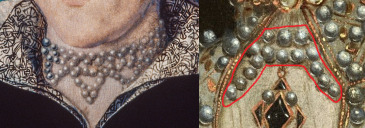
But is not only piece of jewelry in the painting you should focus on. This cross, seems as unimportant accesory. A chest jewel showing that person is of christian fate and nothing more. And perhaps I am wrong and this exact shape of cross is mere concidence.
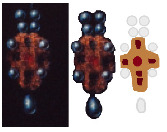
But if I am right, you’ve all seen that cross before. But you’ve probably didn’t study details in Whitehall Mural and questioned the shape of Elizabeth of York’s ruby cross:
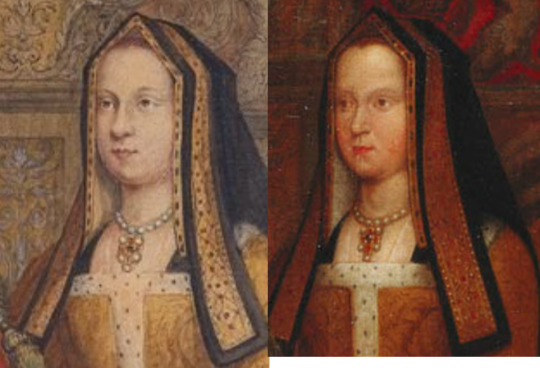
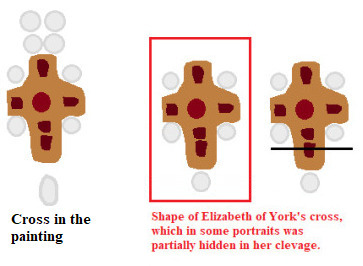
What is different? Bottom pearl and 4 extra pearls on it.
Imo it could be Elizabeth of York’s cross. I cannot rule it out.
Would Mary wear such old jewelry? 50+ years old?
Well I told you in past that Mary during her reign wore this:
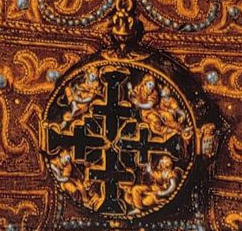
it’s called Tablet of Bourbon and experts have traced it in royal inventories all the way back to reign of Henry V. I didn’t mispell that. Henry the Fifth. He died in 1422! When Mary got depicted with it as Queen, that jewel was 130+ years old. So merely 50+ years old jewelry, she could definitely wear that!
(Wearing old jewelry by royalty is showcase of stability and continuity of line. Even nowadays royals do this and royal watchers discuss which royal lady wore this tiara/necklace/brooch before.)
Now let’s take a look at the second painting.
Trinity College, Oxford’s painting labelled as Elizabeth Pope, neé Blount. (They have 3 copies of it and it is really hard to tell them apart!)
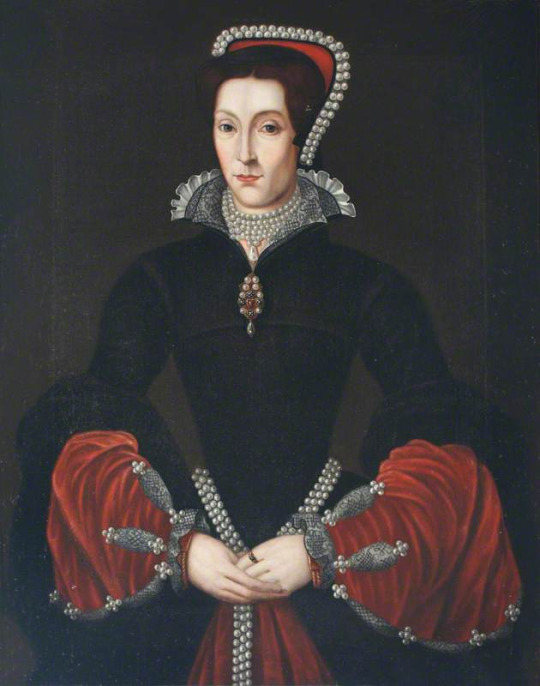
Link to right one(i hope):
https://artuk.org/discover/artworks/elizabeth-blount-lady-thomas-pope-c-15151593-formerly-basford-later-paulet-219507
Elizabeth Pope was wife of founder of the college. Lady of great ambition, and love for jewelry. Her husband was very rich, and at times very powerful.
And in no way his portrait matches his supposed wife:

Both have dark background and are dark to degree, but he has drappery( fabric hangings) behind himself(though it is not very visible), she has solid background. He wears lynx fur, his wife no fur. He wears no jewels(except rings), she wears SO much of it!
This amount of jewelry on non-royal?! Don’t get me wrong-in Elizabethean times-certainly possible and such pearl chains often occured in those days in portraits. But prior?! Not normal at all in 1550s nor 1540s.Should hit you as weird! Immediately. The crimson velvet should hit you as weird.
Yeah I know that guy funded college and was very rich. But in those days unless you were royal, you needed to show some restriction with how you were portrayed. Henry Howard’s got executed mainly because of his portrait! This is meant to be painted after...yet no restriction from those people?
Overall if I look at it together:
This jewelry+crimson+difference with alleged portrait of husband, don’t favour Elizabeth Blount that much.
But what do we know about her husband? Thomas Pope was one of Mary’s council members and favoured by her. (That could potentially explain why his wife could be allowed to wear something she’d normally be not entitled to. We had such case during Henry VIII’s reign.)
He founded the Trinity college as catholic college. During Mary’s reign. His action certainly would please her. Even if she wasn’t official patron, she was in favour of this. And old universities in UK have many lesser known portraits of Tudor royalty, hidden among many other old paintings. They get overlooked.
And if Henry VII could have been mislabelled as Richard III already in 16th century, Mary could have been mislabelled as Elizabeth Pope in 16th century also. Especially given it is atypical depiction of her(possibly). Hence it could certainly be Mary given painting’s history.
But if you look at both paintings, one thing is off. The height of brows is very high for Mary. Every other feature i can find in some portrait of her, can explain by different artists taking on her features, by her health issues, weight loss/gain.

Here look how same the shape of eyes is:

But not the brows. They are too high. It oculd be certainly that artist made mistake and her grandfather’s depictions sometimes have brows very down sometimes very up. So this is explainable.
(And certainly it looks more like her than that portrait in Met Museum. At least to me.)
(She could ahve same shape of eyebrows, which in slightly different angle and tilt of head just look very different.) And especially in copies this can happen. I cannot rule it out. It could simply be that it is poor likeness.
Or it is isn’t her. But Elizabeth of York’s cross and amount of jewelry points to royalty. Alive in 2nd half of 1540s or sometime in 1550s. It’s not Anne of Cleves. But who then?
I’ll be honest here. I do not know it is. I don’t. At least not for sure.
And I am sure many of you will say Mary...that it has her mouth etc...but knowing what I know about Scrots and Eworth...I cannot rule out some of these are artistic similiarities. The artist’s style in which all people, regardless of their actual features, looked alike.
That being said, there is aditional thing which we need to consider here.
The damage to the Illianois painting. It’s not obvious at first glance, unless you look in HD. But there is unfortunately damage to the face, which might mislead you great deal. There are dark patches where shadow shouldn’t be, smudges etc. And it is obvious to me, that those are not how the sitter is supposed to look. The painting’s face was just not restored to get rid of these.
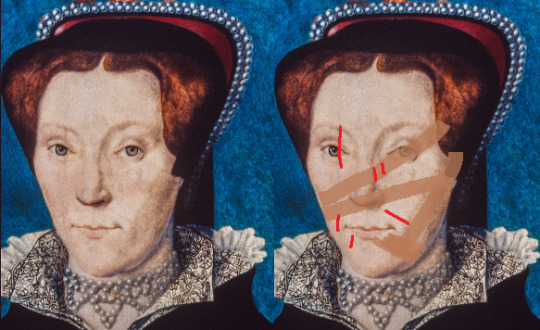
And imo due to this the woman looks maybe even decades older than she actually is. All those supposed wrinkles are actually damage to the painting if you focus on it. Thus...if you remove them, she looks much younger and with nose which at least from en-face or nearly en face, looked much straighter(than the damage makes it appear so).
Probably like this(it’s photoshoped-i wasn’t able to fix the nose entirely):
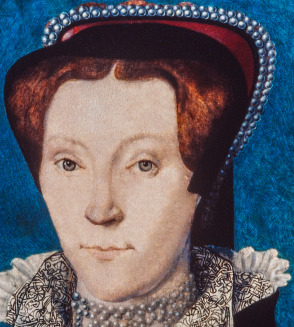
But how young is this woman? Is it 18? Is it 35? It’s hard to say.Mary looked still very young up to cca time of her father’s death(such were genes on her mother’s side of family), and who knows maybe Parr also looked very young.
I think dating for this fashion is c.1546+(after that it is hard to determine due to Mary I’s returning to fashion).
So could it be Mary or Parr in c.1547, or Elizabeth during her brother’s or sister’s reign? Yes, to all three.
But we also know Parr resembled Mary to great degree with main difference being more arched/higher brows.
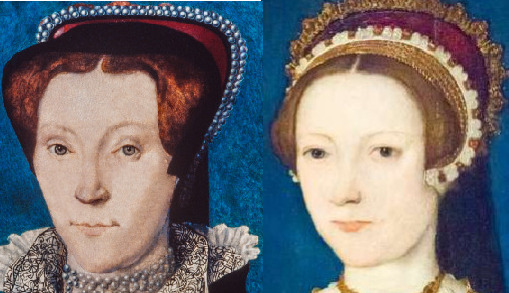
But i am not confident to say it is her. Because as you know, only original we have is not great and we are not 100% sure about her basic features.
Resemblence between Elizabeth and Mary was also pretty good. More than you’ve been told! She is good candidate too. She had hazel eyes-not brown as you imagine her, featurew-wise she would be pretty good fit.
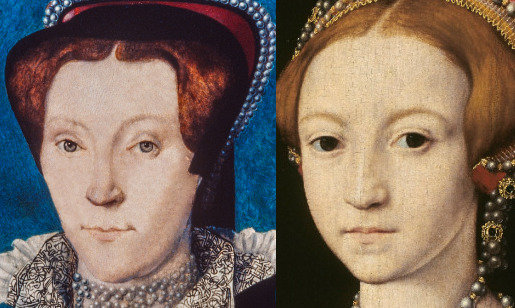
And we lack depictions of her from 1540s and 1550s-where she is on her own. she is in family portraits. Of course Mary has way more because she was ruling Queen and Elizabeth also was not in favour plenty of times in those years. Still there are just cca 3 painting of monarch’s daughter/sister in period of 20 years...(and 2 are based upon family portraits too). The amount is odd! There are bound to be more depictions of her we are not aware of!
Neither is excellent fit. Neither is bad enough fit for me to rule them out.
But while figuring sitter could be younger is good to know, me photoshoping the image and only then comparing faces was bad idea. Because I removed something which is damage and I only realised later.
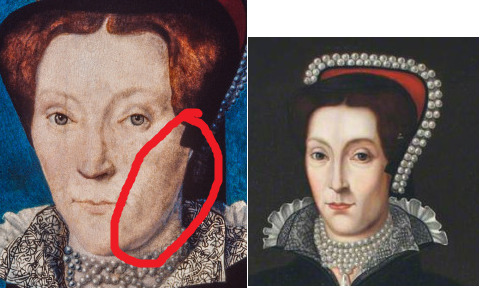
It’s the way cheeks are shaped. With prominent edge to it?(would I call this wrinkle? probably not). It’s kind of similiar to cheeks of Henry VII, but his were of course way more prominent due to age.
And it got me thinking. Could this detail help us narrow it down who it is?
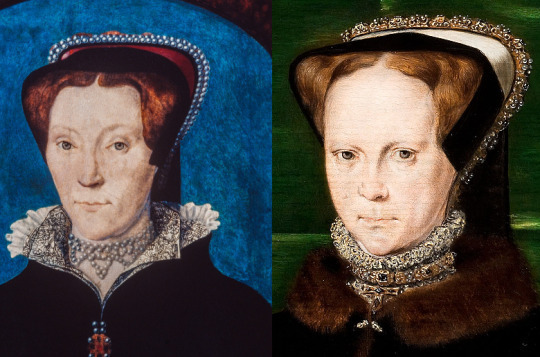
Mary’s cheeks are similiar, but in comparison she has this bulge sticking out of her cheeks. But perhaps that is due to some health condition. I don’t know about her reign but prior Mary had problems with her teeth few times. Could cause swelling in that area.
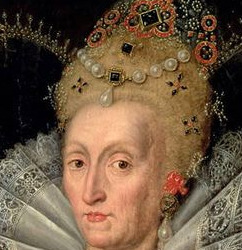
Elizabeth’s depictions if she had it as young woman, her youthful portraits don’t show it(they are idealized). But some of her portraits as old woman show her cheeks resembled that of her grandfather.
However I cannot rule out possibility Parr had it too.
I will be frank. I don’t know which one of them it is!
I’ve been trying to figure out for months now! And I keep changing my mind over whom i think it is. I have finished most of this post in winter. But I kept going all over their portraits, known depictions, features and I keep changing my mind about who i think it is, and then i changed it back and yet again! I’ve done it 6 or 7 times. I have to surrender and admit defeat.
I simply don’t know. At the moment you can take your pick-Mary I, Elizabeth I, Catherine Parr.
Go for it! Who do you think this could be?

I hope you’ve enjoyed this, because for me this was frustrating as hell.
PS: I know some of you speculate if it could be one of Henry VIII’s nieces. But I would like to caution you. if we are talking relatives vs relatives, it can be very hard to determine. You might be sure you found perfect match in features in some depiction of person you like...and still it might not be that person but their cousin who just happened to look very alike. Remember my post about Henry VII vs Richard III. Distant cousins-very similiar face.
Especially given the condition of the American painting, be cautious. I am not sure if nose can be restored properly-i hope so. But we might be looking at issue of flattening nose. And when that occurs it is very hard to tell who it is, because it is such defining feature. So it would be very easy to accidentally identify these portraits wrongly and sometimes it is better to leave it not identified, than wrongly identified.
#Tudor History#historical portraits#mistaken identity#Tudor Jewellery#Mary I Of England#Queen Mary I#elizabeth I#Catherine Parr#queen elizabeth i#elizabeth tudor#mary tudor#katherine parr#based upon jewellery it should be royal#i can't figure it out
7 notes
·
View notes
Text

So when I moved to Outlands, I immediately started attending Scribal nights. Because shocker, unlike some East Kingdom baronies who shall remain nameless, they actually listed the time and location of said Arts nights. 😱
It took two Scribals and a fighter practise to discover that the person who was hosting is the Baroness. 😅 She and the Baron are stepping down soon, so I wanted to make her something to thank her for the work she’s done and for being so welcoming.
Her persona is Tudor, and I loved the double strand pearl necklace worn by several of Henry VIII’s wives. And I tried, but I don’t have the correct double hole beads in my stash to do them, nor do I have the cash to get replica ones.
So instead, it’s a single strand choker, which is also common in Tudor fashion, with a jump ring in the centre for a pendant. Pearls are both white and ivory ‘potato’ pearls, aventurine (also seen on the green Roman Necklace) and amethysts carved into melons from a previous project. There’s also some small gold spacer and cap beads to give the gemstones room to breathe.
Purple and green are pretty much the Barony’s colours, so it’s heraldic!
Prolly could have used glass pearls, but I don’t like how uniform they are for historical jewellery, they’re too perfect. It’s the flaws that make the jewellery interesting.
Anyway, she’ll get this Saturday during polling and hopefully she’ll enjoy it.
7 notes
·
View notes
Text





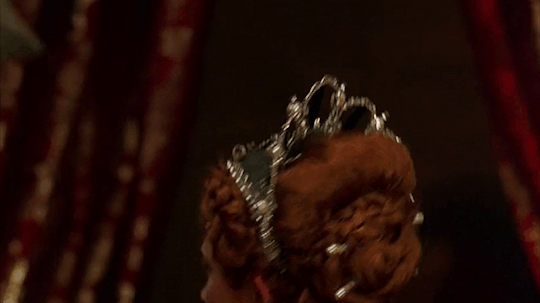









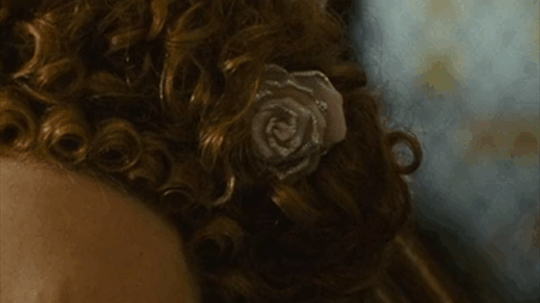




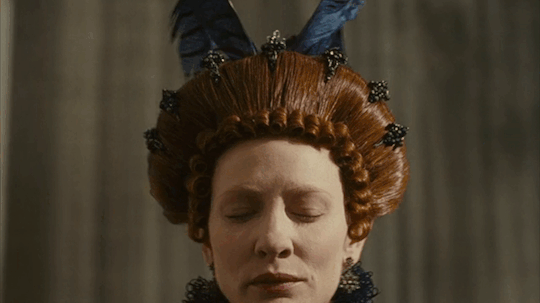



Elizabeth Duology + Headpieces
Queen Elizabeth I's headpieces in Elizabeth (1998) & Elizabeth: The Golden Age.
#Elizabeth Duology#Elizabeth#Elizabeth (1998)#Elizabeth: The Golden Age#Elizabeth I#Elizabeth Tudor#costume drama#costumesource#period drama#perioddramaedit#headpieces#1500s#16th century#crowns and tiaras#crowns#tiaras#flower crowns#hair jewellery#hats#gold#silver#white#black#red#blue#orange#London#England#Britain#Europe
62 notes
·
View notes
Text

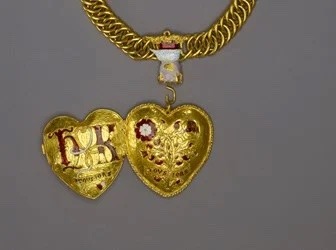
This heart-shaped pendant associated with Henry VIII and Katherine of Aragon was discovered by a metal-detectorist in Warwickshire and now is being unveiled to the public by the British Museum:
“The gold, heart-shaped pendant is attached to a 75-link gold chain via an enamelled ‘hand’.
The front of the pendant is decorated with a red and white Tudor rose motif entwined with a pomegranate bush, the symbols of Henry and Katherine. These stem from the same branch, which at its base has a tail, and sits above the inscription + TOVS + IORS - a pun on the French for ‘always’.
The back shows the letters H and K - for Henry and Katherine - in Lombardic script, linked by ribbon, again with the legend + TOVS + IORS.
Analysis dates the pendant as early 16th century, from 1509 – 1533 AD with a most likely date of around 1521.
It appears that the pendant was produced rapidly; it may have been used as a prize or worn by people participating in an event. The design of the pendant is like that used on horse bards at a joust in Greenwich in 1521.
It is being showcased by the British Museum to highlight the launch of two annual reports – the Treasure Annual Report for 2020 and the Portable Antiquities Scheme (PAS) Annual Report for 2021.”
source: (x)
783 notes
·
View notes
Text



Survived
#Catherine Parr#House of Tudor#Henry VIII#English history#16th century#Henry's last Queen#royal portraits#monarchy#survived#Tudor England#jewellery#courtly dress#UK
21 notes
·
View notes
Photo

13 notes
·
View notes
Text
This Amber necklace is worn on Kelly Macdonald as Isabel Knollys in Elizabeth (1998) and worn on Carice van Houten as Maria Oldknow in From Time to Time (2009) and worn again many years later on Lillith Lesser as Princess Mary I Tudor in Wolf Hall The Mirror and the Light (2024)



#recycled jewellery#elizabeth 1998#kelly macdonald#isabel knollys#from time to time#carice van houten#maria oldknow#Wolf Hall The Mirror and the Light 2024#lillith lesser#princess mary tudor#period drama#historical drama#costume drama#reused jewellery#perioddramaedit#dramasource
12 notes
·
View notes
Text
This golden/black earrings is worn on Natalie Dormer as Anne Boleyn in The Tudors Season 2 (2008) and later worn on Eva Green as Morgan le Fay in Camelot (2011)


#recycled jewellery#the tudors#natalie dormer#anne boleyn#camelot#eva green#morgan le fay#costume drama#reused jewellery#perioddramasource#dramasource#historical drama
4 notes
·
View notes
Text
This Beads necklace is worn two times in The Tudors, First worn on Catherine of Aragon in Season 1 (2007) and later worn on Catherine Parr in Season 4 (2010)
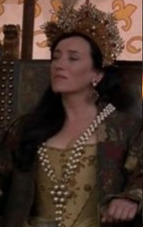
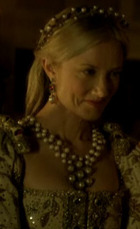
#recycled costumes#the tudors#maria doyle kennedy#catherine of aragon#joely richardson#catherine parr#period drama#historical drama#costume drama#reused jewellery#recycled jewellery#reused costume
6 notes
·
View notes
Text
This headpices with stones and pearls on is worn on Natalie Dormer ss Anne Boleyn in The Tudors Season 1 (2007) and is worn years later on an ekstra in Doctor Who Special: Joy to the World (2024)



#recycled costumes#the tudors#natalie dormer#anne boleyn#doctor who#costume drama#reused jewellery#period drama#historical drama#perioddramasource#dramasource
1 note
·
View note
Text
So I accidentally almost got into an argument on Twitter, and now I'm thinking about bad historical costuming tropes. Specifically, Action Hero Leather Pants.
See, I was light-heartedly pointing out the inaccuracies of the costumes in Black Sails, and someone came out of the woodwork to defend the show. The misunderstanding was that they thought I was dismissing the show just for its costumes, which I wasn't - I was simply pointing out that it can't entirely care about material history (meaning specifically physical objects/culture) if it treats its clothes like that.
But this person was slightly offended on behalf of their show - especially, quote, "And from a fan of OFMD, no less!" Which got me thinking - it's true! I can abide a lot more historical costuming inaccuracy from Our Flag than I can Black Sails or Vikings. And I don't think it's just because one has my blorbos in it. But really, when it comes down to it...
What is the difference between this and this?
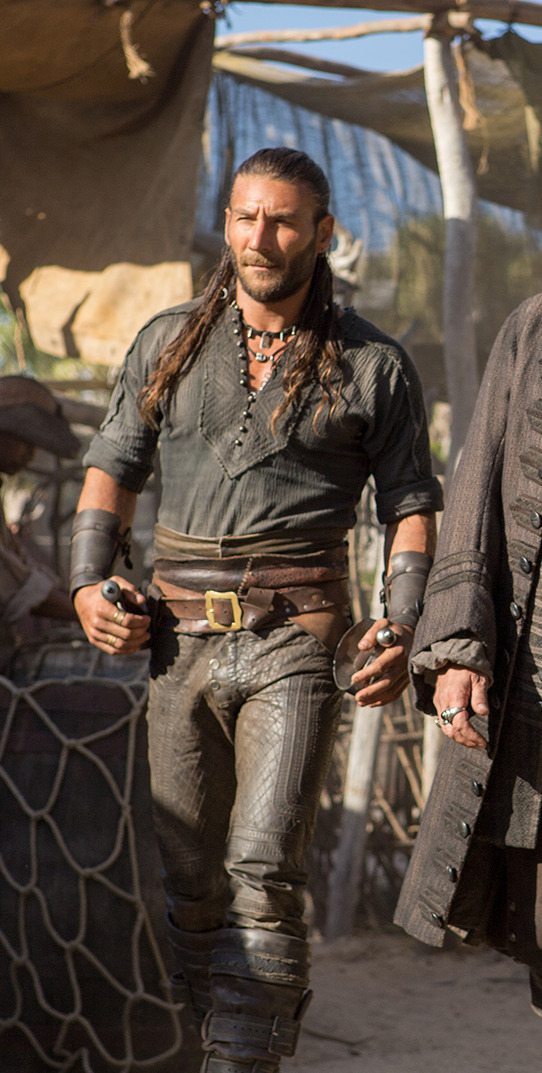
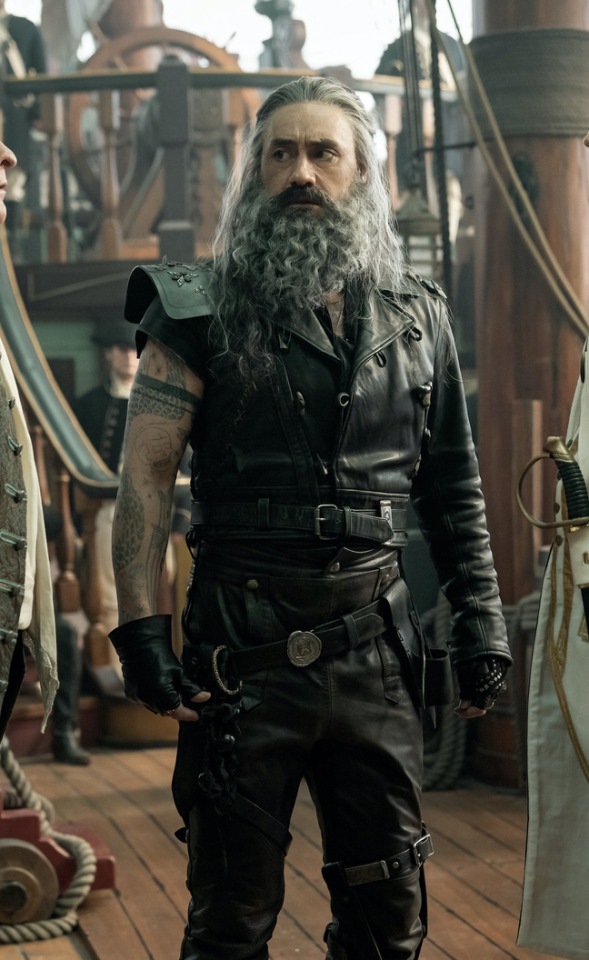
Here's the thing. Leather pants in period dramas isn't new. You've got your Vikings, Tudors, Outlander, Pirates of the Caribbean, Once Upon a Time, Will, The Musketeers, even Shakespeare in Love - they love to shove people in leather and call it a day. But where does this come from?

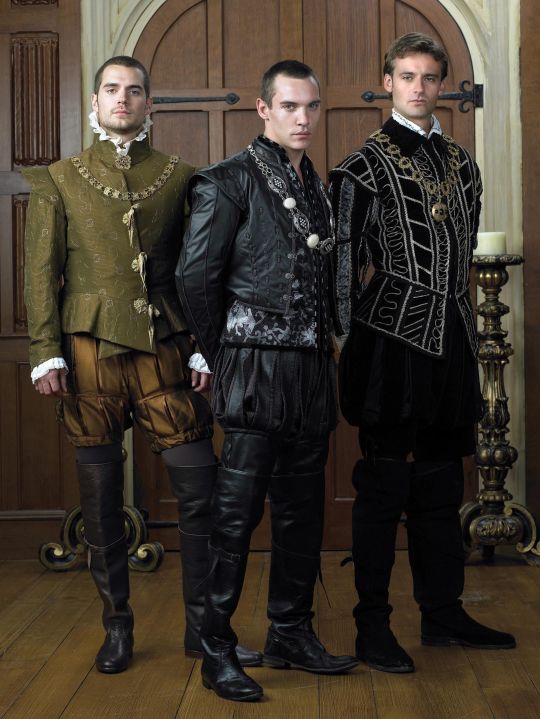
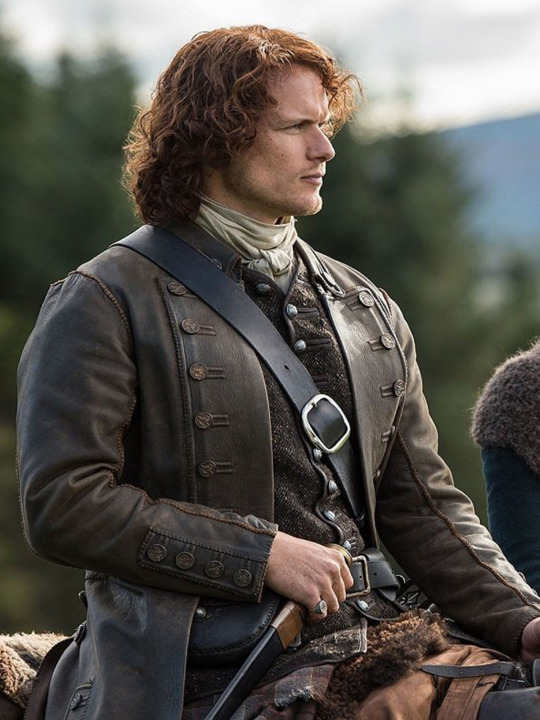

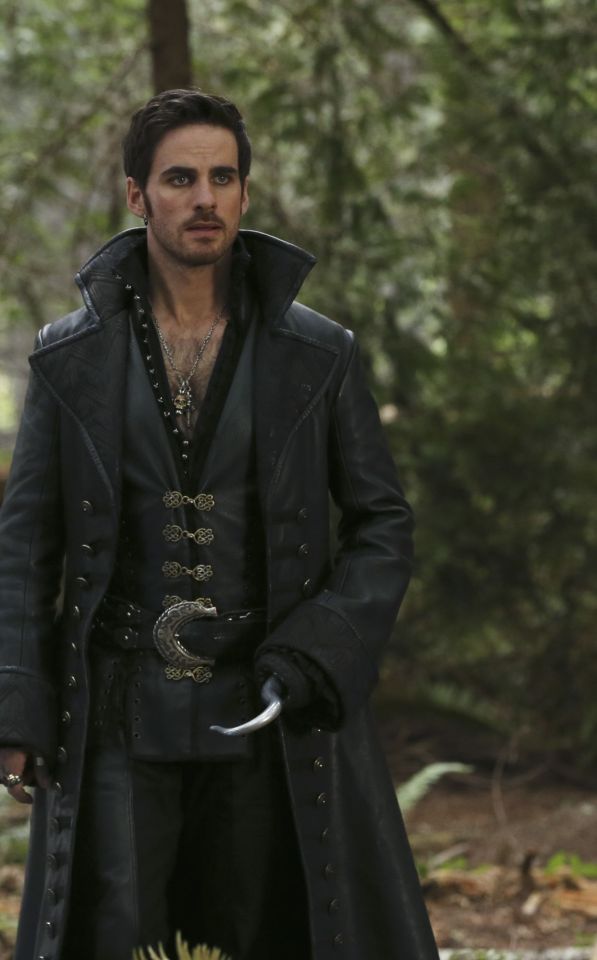


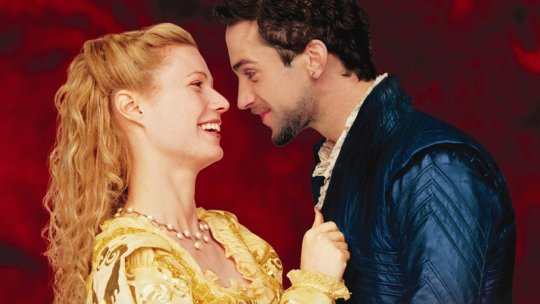
Obviously we have the modern connotations. Modern leather clothes developed in a few subcultures: cowboys drew on Native American clothing. (Allegedly. This is a little beyond my purview, I haven't seen any solid evidence, and it sounds like the kind of fact that people repeat a lot but is based on an assumption. I wouldn't know, though.) Leather was used in some WWI and II uniforms.
But the big boom came in the mid-C20th in motorcycle, punk/goth, and gay subcultures, all intertwined with each other and the above. Motorcyclists wear leather as practical protective gear, and it gets picked up by rock and punk artists as a symbol of counterculture, and transferred to movie designs. It gets wrapped up in gay and kink communities, with even more countercultural and taboo meanings. By the late C20th, leather has entered mainstream fashion, but it still carries those references to goths, punks, BDSM, and motorbike gangs, to James Dean, Marlon Brando, and Mick Jagger. This is whence we get our Spikes and Dave Listers in 1980s/90s media, bad boys and working-class punks.

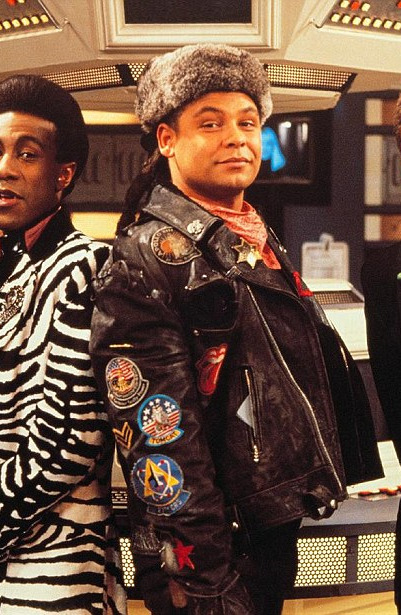
And some of the above "historical" design choices clearly build on these meanings. William Shakespeare is dressed in a black leather doublet to evoke the swaggering bad boy artist heartthrob, probably down on his luck. So is Kit Marlowe.
But the associations get a little fuzzier after that. Hook, with his eyeliner and jewellery, sure. King Henry, yeah, I see it. It's hideously ahistorical, but sure. But what about Jamie and Will and Ragnar, in their browns and shabby, battle-ready chic? Well, here we get the other strain of Bad Period Drama Leather.
See, designers like to point to history, but it's just not true. Leather armour, especially in the western/European world, is very, very rare, and not just because it decays faster than metal. (Yes, even in ancient Greece/Rome, despite many articles claiming that as the start of the leather armour trend!) It simply wasn't used a lot, because it's frankly useless at defending the body compared to metal. Leather was used as a backing for some splint armour pieces, and for belts, sheathes, and buckles, but it simply wasn't worn like the costumes above. It's heavy, uncomfortable, and hard to repair - it's simply not practical for a garment when you have perfectly comfortable, insulating, and widely available linen, wool, and cotton!
As far as I can see, the real influence on leather in period dramas is fantasy. Fantasy media has proliferated the idea of leather armour as the lightweight choice for rangers, elves, and rogues, a natural, quiet, flexible material, less flashy or restrictive than metal. And it is cheaper for a costume department to make, and easier for an actor to wear on set. It's in Dungeons and Dragons and Lord of the Rings, King Arthur, Runescape, and World of Warcraft.
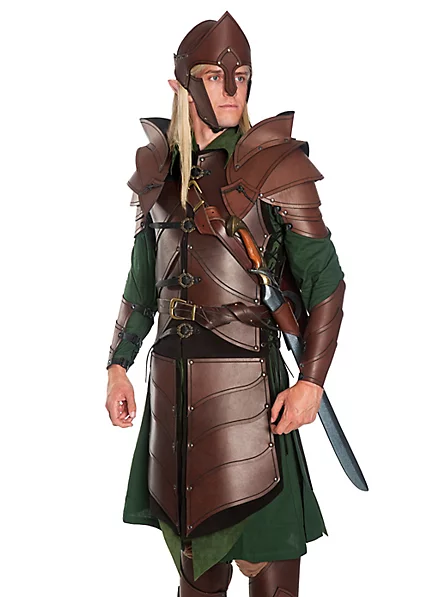
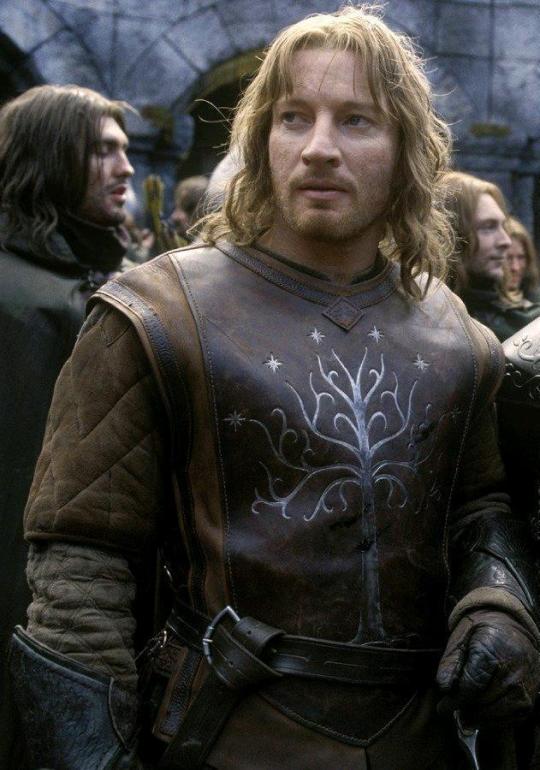
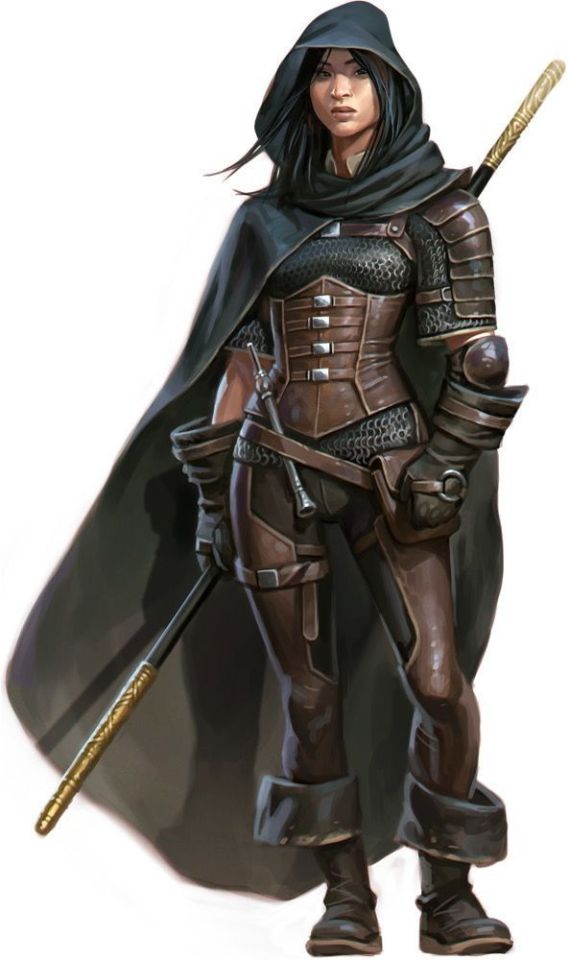
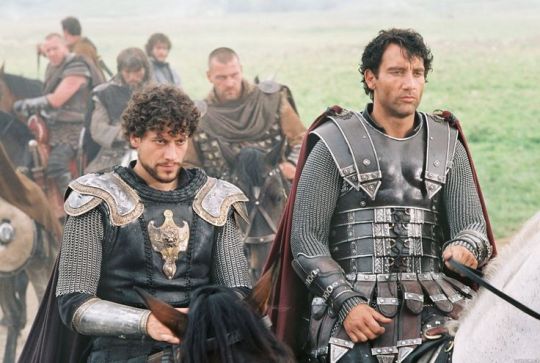

And I think this is how we get to characters like Ragnar and Vane. This idea of leather as practical gear and light armour, it's fantasy, but it has this lineage, behind which sits cowboy chaps and bomber/flight jackets. It's usually brown compared to the punk bad boy's black, less shiny, and more often piecemeal or decorated. In fact, there's a great distinction between the two Period Leather Modes within the same piece of media: Robin Hood (2006)! Compare the brooding, fascist-coded villain Guy of Gisborne with the shabby, bow-wielding, forest-dwelling Robin:
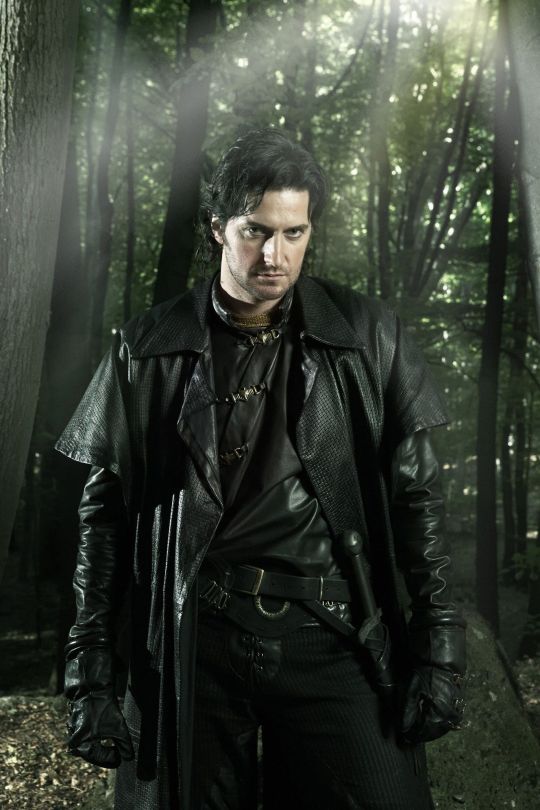

So, back to the original question: What's the difference between Charles Vane in Black Sails, and Edward Teach in Our Flag Means Death?
Simply put, it's intention. There is nothing intentional about Vane's leather in Black Sails. It's not the only leather in the show, and it only says what all shabby period leather says, relying on the same tropes as fantasy armour: he's a bad boy and a fighter in workaday leather, poor, flexible, and practical. None of these connotations are based in reality or history, and they've been done countless times before. It's boring design, neither historically accurate nor particularly creative, but much the same as all the other shabby chic fighters on our screens. He has a broad lineage in Lord of the Rings and Pirates of the Caribbean and such, but that's it.
In Our Flag, however, the lineage is much, much more intentional. Ed is a direct homage to Mad Max, the costuming in which is both practical (Max is an ex-cop and road warrior), and draws on punk and kink designs to evoke a counterculture gone mad to the point of social breakdown, exploiting the thrill of the taboo to frighten and titillate the audience.
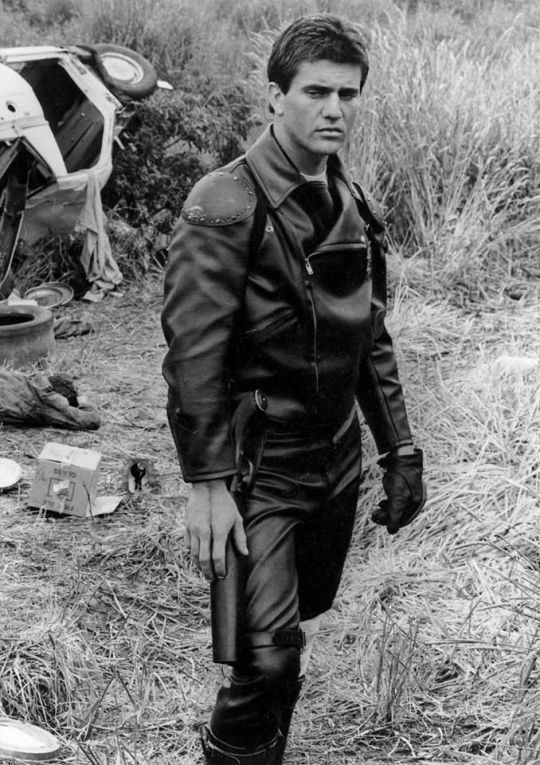
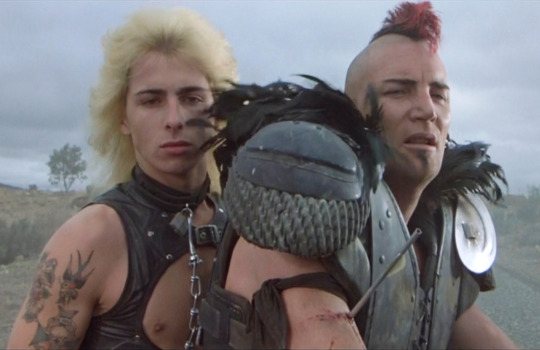
In particular, Ed is styled after Max in the second movie, having lost his family, been badly injured, and watched the world turn into an apocalypse. He's a broken man, withdrawn, violent, and deliberately cutting himself off from others to avoid getting hurt again. The plot of Mad Max 2 is him learning to open up and help others, making himself vulnerable to more loss, but more human in the process.

This ties directly into the themes of Our Flag - it's a deliberate intertext. Ed's emotional journey is also one from isolation and pain to vulnerability, community, and love. Mad Max (intentionally and unintentionally) explores themes of masculinity, violence, and power, while Max has become simplified in the popular imagination as a stoic, badass action hero rather than the more complex character he is, struggling with loss and humanity. Similarly, Our Flag explores masculinity, both textually (Stede is trying to build a less abusive pirate culture) and metatextually (the show champions complex, banal, and tender masculinities, especially when we're used to only seeing pirates in either gritty action movies or childish comedies).
Our Flag also draws on the specific countercultures of motorcycles, rockers, and gay/BDSM culture in its design and themes. Naturally, in such a queer show, one can't help but make the connection between leather pirates and leather daddies, and the design certainly nods at this, with its vests and studs. I always think about this guy, with his flat cap so reminiscient of gay leather fashions.
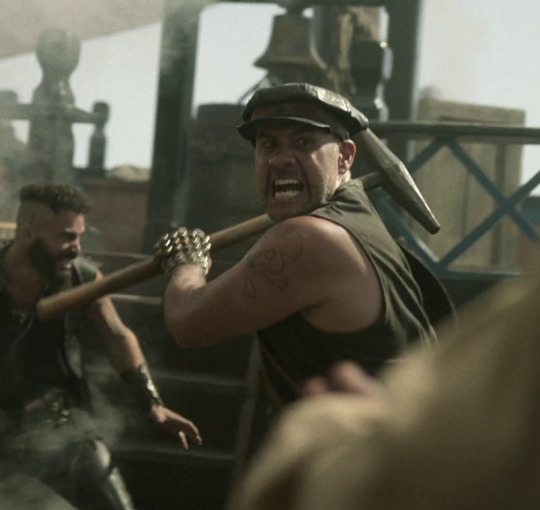
More overtly, though, Blackbeard and his crew are styled as both violent gangsters and countercultural rockstars. They rove the seas like a bikie gang, free and violent, and are seen as icons, bad boys and celebrities. Other pirates revere Blackbeard and wish they could be on his crew, while civilians are awed by his reputation, desperate for juicy, gory details.
This isn't all of why I like the costuming in Our Flag Means Death (especially season 1). Stede's outfits are by no means accurate, but they're a lot more accurate than most pirate media, and they're bright and colourful, with accurate and delightful silks, lace, velvets, and brocades, and lovely, puffy skirts on his jackets. Many of the Revenge crew wear recognisable sailor's trousers, and practical but bright, varied gear that easily conveys personality and flair. There is a surprising dedication to little details, like changing Ed's trousers to fall-fronts for a historical feel, Izzy's puffy sleeves, the handmade fringe on Lucius's red jacket, or the increasing absurdity of navy uniform cuffs between Nigel and Chauncey.
A really big one is the fact that they don't shy away from historical footwear! In almost every example above, we see the period drama's obsession with putting men in skinny jeans and bucket-top boots, but not only does Stede wear his little red-heeled shoes with stockings, but most of his crew, and the ordinary people of Barbados, wear low boots or pumps, and even rough, masculine characters like Pete wear knee breeches and bright colours. It's inaccurate, but at least it's a new kind of inaccuracy, that builds much more on actual historical fashions, and eschews the shortcuts of other, grittier period dramas in favour of colour and personality.
But also. At least it fucking says something with its leather.
#everyone say 'thank you togas' for not including a long tangent about evil rimmer in red dwarf 5x05#Our Flag Means Death#Togas does meta#and yes these principles DO fall apart slightly in s2 and i DON'T like those costumes as much#don't get me wrong they're fun and gorgeous - but generally a bit less deep and more inaccurate. so. :(#I'm not sure this really says anything new about Our Flag but I just needed to get my thoughts out#i hate hate hate Gritty Period Drama costumes they're so boring and so ugly and so wrong#god bless OFMD for using more than 3 muted colours and actually putting men in heels (and not as a shorthand for rich/foppish villainy) <3#looking at that Tudors still is insane like they really will go to any lengths to not make men feel like they've got bare legs XD#image descriptions in alt text#and yes i DID just sink about two hours into those so you'd better appreciate them
1K notes
·
View notes
Text
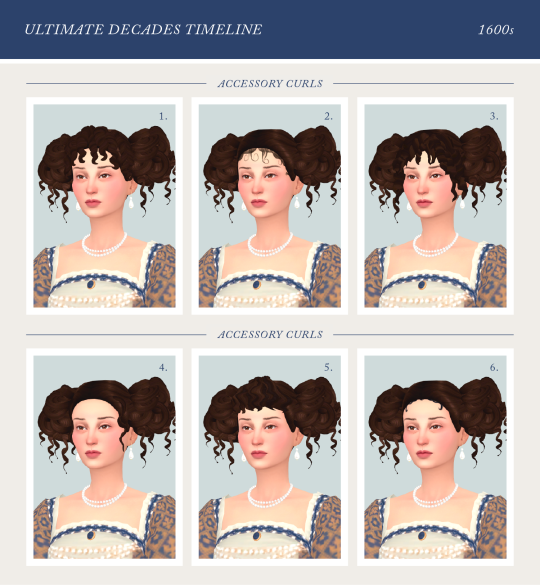
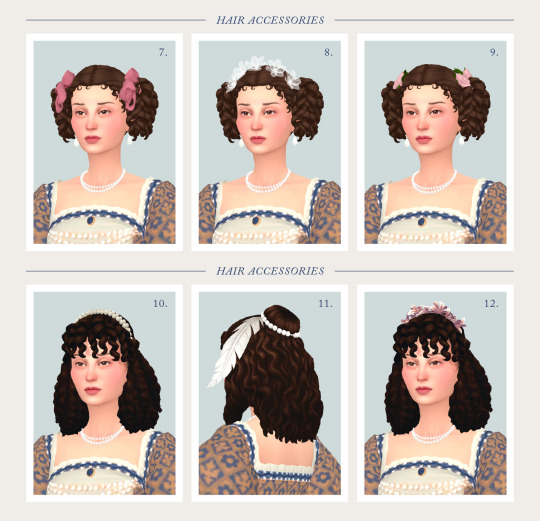
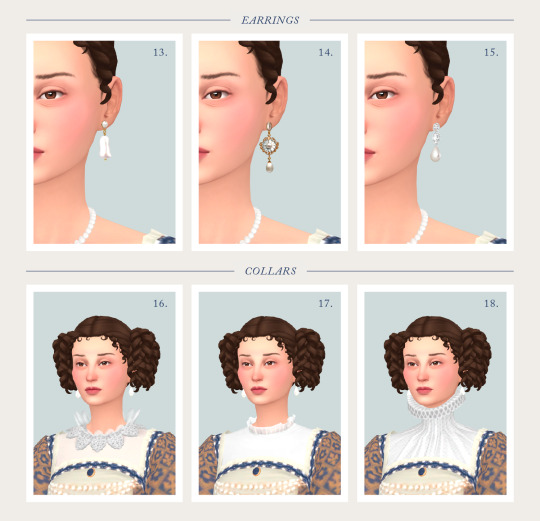


1600s WOMEN - PART 2
In the early part of the 17th century holdovers from the Tudor period continued to be in style, but soon enough the iconic ruff would evolve into delicate soft and standing lace collars. By the 1620s women's fashion - and by extension their accessories - became a lot more simple. Hats kept growing in size from the previous century, both in width and height. Pearls were HUGELY popular as they were a way to display wealth. In fact, it's hard to find a woman's portrait from this period that doesn't feature pearl jewellery. CC links and reference images under the cut.
You can find more of my historical content here:
1300s ✺ 1400s ✺ 1500s ✺ 1600s ✺ 1700s
1 - Twisted Accessory Bangs by Atashi77
2 - Babyhair N3 by Daerilia
3 - Venice Accessory Bangs by Atashi77
4 - Fringe Accessory Bangs by Atashi77
5 - Parisa Bangs Shortened by Vintage Simstress
6 - Babyhair Collection by Sheabuttyr
7 - WW Bow Accessory by Gilded Ghosts
8 - Wreath Headdress by S-Club (TSR)
9 - Violet Accessory by Sims To Maggie
10 - Pearl Tiara Recolor by Peebs
11 - Pearls & Feather Hair Accessory by Melancholy Maiden
12 - Tire N1 by Wings (TSR)
13 - Baroque Pearl Drop Earrings by Feyona (TSR)
14 - Flower Earrings by S-Club (TSR)
15 - Katy Earrings V3 by Glitterberry Sims (TSR)
16 - Highbury Chemisette by Gilded Ghosts | Crochet Collar by Waekey
17 - Sweet Collar by Waekey | Jolie Accessory Bodysuit by Dissia (TSR)
18 - Ruff Collar by Strange Storyteller Sims
19 - Josephine Pearl Necklace by Bats From Westeros
20 - Malibu Necklace by Joliebean
21 - Veronica Necklace by Glitterberry Sims (TSR)
22 - Duchess Pearl Necklace by Yakfarm
23 - Belle der Mere Pearl Macys by Redhead Sims
24 - Classic Pearls by Glitterberry Sims (TSR)
25 - Lady Hat V2 by Elfdor
26 - Witch Hunter Hat by Kennetha V (TSR)
27 - Bow Hat by Joolster
28 - Top Hat by Count Cosmos
29 - Vintage Glam Hat by Madlen
30 - Felicity Hat by Ilkup
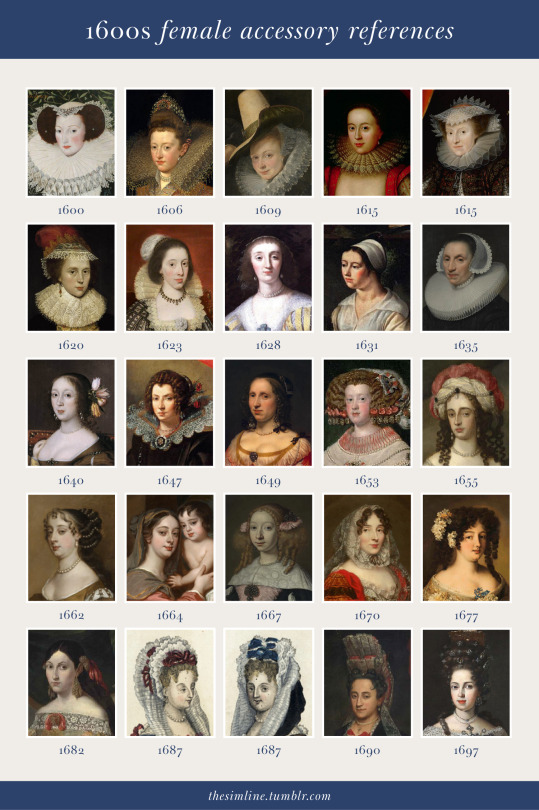
With thanks to some amazing creators: @daerilia @vintagesimstress @sheabuttyr @simstomaggie @peebsplays @the-melancholy-maiden @glitterberrysims @waekey @strangestorytellersims @batsfromwesteros @joliebean @yakfarm @redheadsims-cc @elfdor @madlensims @ilkup
#ultimate decades challenge#ts4 decades challenge#ts4 historical#1600s#baroque#ts4#ts4 cc cas#the sims 4#sims 4 decades challenge#ts4 history challenge#sims 4 history challenge#sims 4 historical#historical cc#17th century
368 notes
·
View notes
Note
Can you do Separately what The Yandere Tudors Men (Edward Seymour, King Henry VIII, Charles Brandon and Thomas Boleyn) would give their Wife a really, REALLY expensive necklace either as a wedding present, a just because present or something following the birth of one of their children?
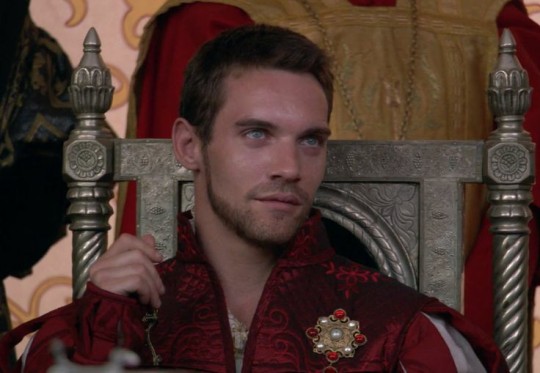
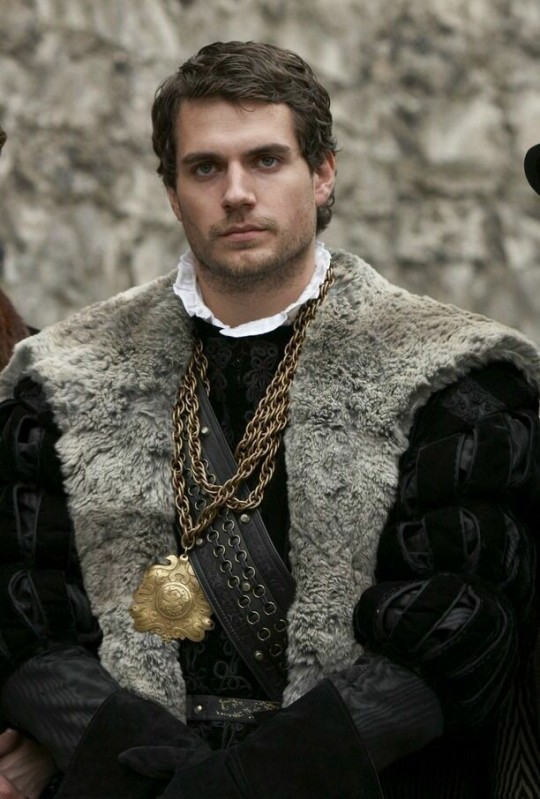
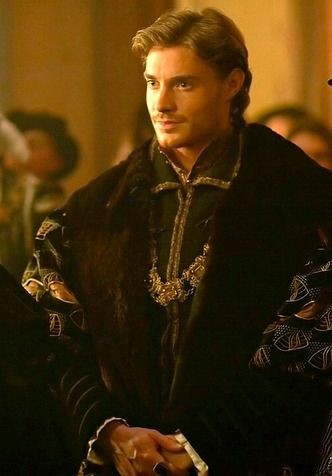
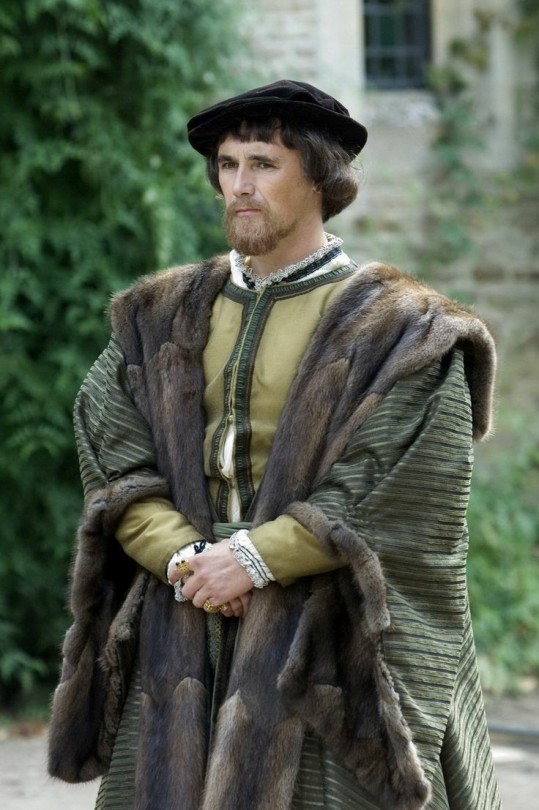
Hello. I hope you like it.
King Henry had passed many difficult trials to marry you. You will never forget the moments of lust and desire you experienced on your wedding night throughout your life. King Henry shed tears of joy when he received the news that you were pregnant. He took very close care of you throughout your pregnancy, unlike usual. Not even a minute was left outside the door of the room where you gave birth for hours. He was praying to God for you and the baby to be delivered safely. When the birth was finally over, he quickly entered the room. You were tiredly smiling at your husband with your newborn son in your arms.
"My King. We now have a male heir."
King Henry came to you and kissed your forehead. It wasn't hard to understand that he was happy and proud from the look on his face when he held your son in his arms.
"My son."
King Henry proudly kissed his newborn son's forehead.
"Our son's name will be Edward. Prince Edward."
You smiled at your husband's words. King Henry gently placed Prince Edward in his crib. He handed you the box in his hand. Surprised, you take the box and open it. Inside the box was a necklace decorated with Tudor symbol roses and made of expensive jewellery.
"My King. This is beautiful."
"Not as much as you."
King Henry took the necklace out of the box and placed it around your neck elegantly.
◇◇◇◇◇◇◇◇◇◇◇◇◇◇◇◇◇◇◇◇◇◇◇◇
You were Charles' third wife. Honestly, you never thought that an arranged marriage would turn into love. Charles was a possessive and passionate husband. Even though his love was suffocating at times, you had learned to cope. Charles did not yet have a son. This meant that a big task was on your shoulders. You got pregnant shortly after the wedding. You honestly thought your husband would move away from you and take mistresses. But it didn't happen as he thought. Months later, you gave birth to healthy twin boys. You would never forget the smile on Charles' face. He held his sons in his arms and wasn't afraid to talk about how proud he was. One of your sons was named John and the other Edmund. After naming the babies, Charles gave you a very dazzling necklace as a gift. From what you heard from your bridesmaids, Charles paid a really large amount of money for this necklace.
◇◇◇◇◇◇◇◇◇◇◇◇◇◇◇◇◇◇◇◇◇◇◇◇
Your wedding to Thomas Boleyn was modest. You came from a noble and powerful family. Frankly, your mother and father were not very keen on this marriage. After all, Thomas Boleyn did not promise great possibilities. After months of conversations, you had finally managed to gain your family's approval. You were getting ready in your room on the wedding night. Thomas slowly pokes his head through the door.
"I got you something, honey. Your wedding gift."
"There was no need, my dear. It is a great gift for me to know that we can spend our lives together now."
"My beautiful wife. I am truly a very lucky man."
Thomas holds out the box he keeps behind his back. You slowly take the box and open it. There is a really expensive necklace inside the box.
"Thomas. This is too expensive."
"I couldn't have a big wedding that suits you. I should have at least bought you a gift that suits you."
"Thank you, Thomas. I will keep this necklace for the rest of my life."
◇◇◇◇◇◇◇◇◇◇◇◇◇◇◇◇◇◇◇◇◇◇◇◇
Your wedding to Edward Seymour was beautiful. It was literally like a fairy tale. Queen Jane had spared no expense for her brother's wedding. The wedding hall was decorated very beautifully. A luxurious wedding dress and a wonderful flower bouquet were prepared. After you put on your wedding dress, the bridesmaids did your make-up and hair. You were waiting for the ceremony to start. There is a knock on your door.
"Come in."
Edward comes in. Edward has a look of admiration on his face.
"Oh my God. You look like an angel."
"Edward, you're embarrassing me."
"I came to give you a gift. I hope you like it."
When you open the box, you are surprised to see the expensive necklace inside.
"Oh. Edward, that's beautiful."
"I'm glad you liked it, my beautiful."
#yandere the tudors#house of tudor#yandere tudors#yandere tudors characters#the tudors#yandere edward seymour#yandere edward seymour x reader#yandere charles brandon#yandere charles brandon xreader#yandere thomas boleyn#yandere thomas boleyn x reader#yandere henry viii#yandere henry viii x reader#yandere king henry viii#yandere historycal characters#yandere male
216 notes
·
View notes
Text
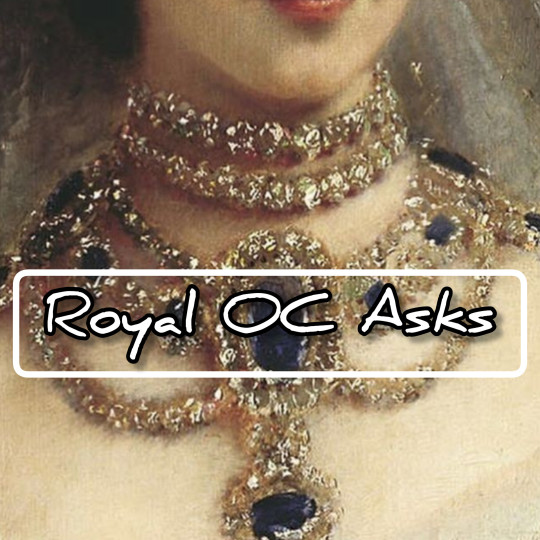
Asks for a Royal WIP or a Royal AU.
What rank is your OC?
How are they addressed?
Do they always expect to be addressed formally at all times? Are they comfortable with it?
Where do they stand in the succession? How do they feel about this?
What sort of succession system is it? Agnatic? Primogeniture? Gender-biased?
What sort of monarchy does your OC belong to? Do they like this style?
What's your OC's opinion on Monarchy? Do they believe in it? Are they for or against? Reasons why?
How did the dynasty come to be?
What is the dynasty known for? Are they bloody like the Tudors? Are they fabulously wealthy like the Romanovs? Are they... A loving family like the Hapsburgs? *opening twangs of Sweet Home Alabama*
Is the dynasty old? Or new? How does this effect how they operate?
Are they traditionalists or modernise?
What do the people think of the royal family? Are they headed toward Monseiur Guillotine? Or treasured?
Is there a famous ancestor they look up to? One they would rather not speak about?
Are there any pretenders to the Crown? If so, who are they and why do they believe they have a right to the throne?
What are some monuments built by the dynasty?
What are some duties your OC is expected to perform? Military service? The bestowing of honours? Attending the monarch at large events?
Does your OC dislike living in the public eye? Or do they believe it's part of the job?
Where does your OC live?
How many palaces, castles and homes does your OC call home?
Has your OC ever been on a tour of their country? What's their favourite region?
How does your OC view politics? Are they a reformer or do they prefer to hide from change?
Your OC has a day engagement. What do they wear?
Your OC has a state occasion. What do they wear?
Does your OC enjoy ceremonial ornaments such as orders, tiaras, uniforms and crowns? If not, why? If so, why?
Do they enjoy large public occasions? Do they enjoy the pomp and ceremony?
Somebody has neglected to bow/curtsy in an effort to insult. What does your OC do in response?
They encounter somebody who doesn't recognise them but they are friendly. Does your OC a) immediately inform them b) leave them off and just have a nice chat c) other option.
Are they known for their fashion taste?
Does your OC do any charity work? What are some charities they support?
How does the press characterize your OC? Are they a darling or a devil?
Your OC has been the target of some bad press. What to they do to straighten out the story?
Has your OC ever escaped the palace for an adventure?
What are some famous pieces of jewellery owned by the royal family?
How does jewellery work in the family? Who can wear what pieces? Who decides this?
Do they have servants? Is your OC liked by the servants? If not, why?
Are they close to anybody who isn't royal? A servant? A companion?
Does your OC ever hate being born royal?
Are there any restrictions on them because they are royal? Can they marry as they like? Live how they want? Is there anything they are utterly barred from doing?
What are some expectations your OC must live up to? Can they fulfil them? If not, why not?
What are some ridiculous rules they must follow?
How rigid is royal life?
What privileges are they entitled to?
How does being royal effect how they act? Are they predisposed to snobbery? Or do they believe themselves above others?
Have they ever had a scandal? If so, details.
What is your OC known for? Their hardwork? Their duty? Their wild social life?
If your OC ever had to choose between what's best for the Crown or themselves, what would they choose?
If they are ever offered the chance of power, would they oust the monarch?
If the monarch was in danger of running the country into the ground, would your OC rebel against them?
There's a revolution and everyone wants the royals dead. What does your OC do? A) Join the Revolution B) RUN C) Stay and keeping living the high life (god that mob is getting close) D) Betray their family and give them to the mob to save themselves.
Your OC has been invited to a large party on the eve of a very bad disaster which has killed and wounded many. Do they attend the party? Or head to the site to help or at very least show they care?
I will accept asks for Misha, Olezka, Katya, Sergei.
#OC ask game#Royal OC ask game#Royal ocs#Royal au#OC asks#Royal#writing#writeblr#writing resources#writing reference#writing advice#writer#spilled words#writers
375 notes
·
View notes
Photo

William Scrots, Elizabeth I when a Princess (1533-1603), 1546/1547
13 notes
·
View notes
Text
This golden/black earrings is worn on Natalie Dormeras as Anne Boleyn in The Tudors Season 2 (2008) and later worn on Eva Green as Morgan le Fay in Camelot (2011)


#recycled jewellery#the tudors#natalie dormer#anne boleyn#camelot#eva green#morgan le fay#costume drama#historical drama#reused jewellery#dramasource#drama series#source: historicalreusedcostumes
10 notes
·
View notes